Saturday, April 24
Paula: Every now and then, each of us experiences a moment that
we know we will remember forever - today we were all blessed with one of these
occasions. 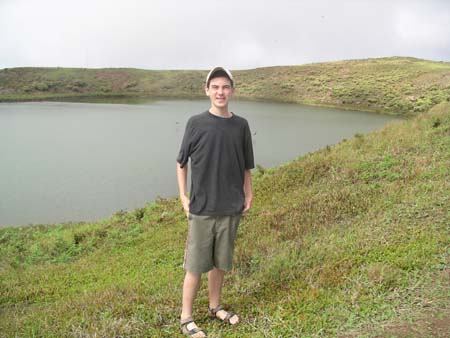
During the night our ship had traveled back to our original starting point
in San Cristobal, as some passengers were leaving and others joining the cruise.
While on San Cristobal, we had an opportunity to view the island's highlands.
After a 40 minute bus ride, we climbed for about 5-10 minutes to the summit
of a volcano which defined San Cristobal Island. The collapsed crater has
become a lake (called "El Junco") and in 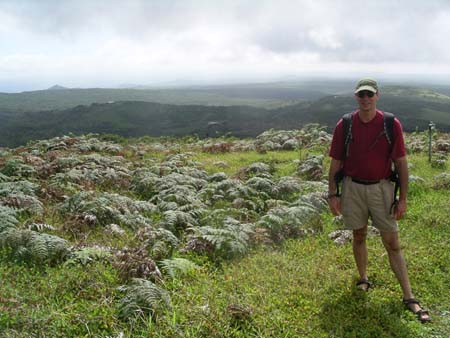 fact
is the only fresh water lake in all of the Galapagos Islands. We enjoyed a
pleasant walk around the lake observing some of the endemic plants like the
maconia bush. Our naturalist explained that the blackberry bushes that we
saw were introduced by people who are living in the islands and that their
invasive nature is a huge concern. They were originally planted on farms,
fact
is the only fresh water lake in all of the Galapagos Islands. We enjoyed a
pleasant walk around the lake observing some of the endemic plants like the
maconia bush. Our naturalist explained that the blackberry bushes that we
saw were introduced by people who are living in the islands and that their
invasive nature is a huge concern. They were originally planted on farms,
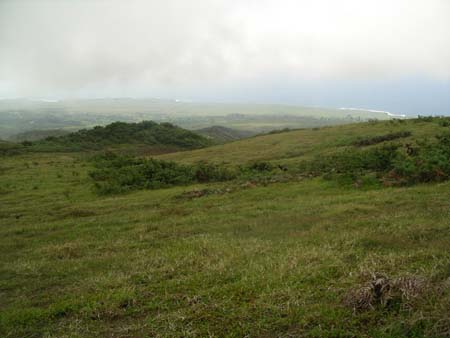 but
have now been spread by birds into multiple locations. As we left the crater,
a large group of local volunteers were hiking up with knives and shovels preparing
to work on removing blackberry bushes from the landscape.
but
have now been spread by birds into multiple locations. As we left the crater,
a large group of local volunteers were hiking up with knives and shovels preparing
to work on removing blackberry bushes from the landscape.
The lake is much smaller than the volcanic lake we saw by the Cotacachi Volcano in Ecuador's highlands, and has a depth of only 1-6 meters. Frigate birds circled the lake and periodically skimmed across the water. We thought they were fishing but our guide explained that they were actually bathing themselves to get rid of the salt water. We discovered that the lake is relatively new (only 50,000 years old), and has been filled over thousands of years with rain water. Recently a scientist dug down 16 meters into the sediment and identified many endemic plants which are now extinct. Hundreds of scientists from all over the world still come here and to many places in the Galapagos Islands to continue Darwin's work.
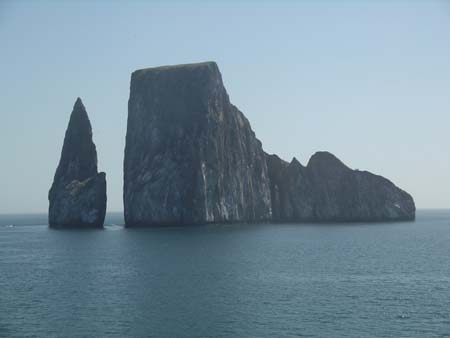 In
the afternoon as the ship cruised toward the other side of San Cristobal,
we had an opportunity to view a famous landmark called "The Sleeping
Lion"or "Kicker Island". This island is actually composed of
two large cliff-like rocks and is home to many species of birds.
In
the afternoon as the ship cruised toward the other side of San Cristobal,
we had an opportunity to view a famous landmark called "The Sleeping
Lion"or "Kicker Island". This island is actually composed of
two large cliff-like rocks and is home to many species of birds.
We disembarked later in the afternoon at Cerro Brujo Beach. This long, white
sand beach is striking when viewed against the blue sky and aqua waters that
line its shores. Several colonies of sea lions basked along the shores and
we also saw boobies, frigate birds and oyster catchers. We quickly donned
our snorkeling gear and 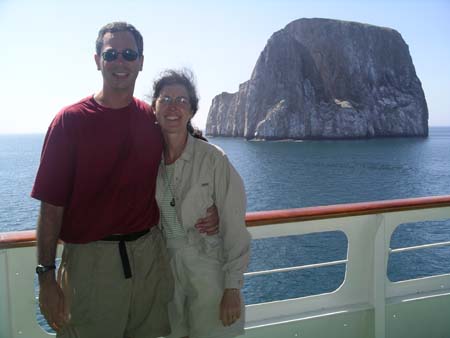 plunged
into the water in hopes of spotting more of the marine life here. Unfortunately,
the water was a bit cloudy making it difficult to visualize the fish. We decided
to get out and walk along this long beach, when suddenly we saw a sea lion
swimming with a snorkeler just off the shore. We quickly ran back to get our
masks and fins, suited up and jumped right in.
plunged
into the water in hopes of spotting more of the marine life here. Unfortunately,
the water was a bit cloudy making it difficult to visualize the fish. We decided
to get out and walk along this long beach, when suddenly we saw a sea lion
swimming with a snorkeler just off the shore. We quickly ran back to get our
masks and fins, suited up and jumped right in.
This playful juvenile sea lion seemed overjoyed to have our company. He literally
came up and touched our masks with his nose to check each of us out on several
occasions. His big eyes and long whiskers were amazing. He swam under us,
around us and even splashed us with his flippers. He looked to be almost intentionally
showing off has he somersaulted repeatedly directly in front of us. Sometimes
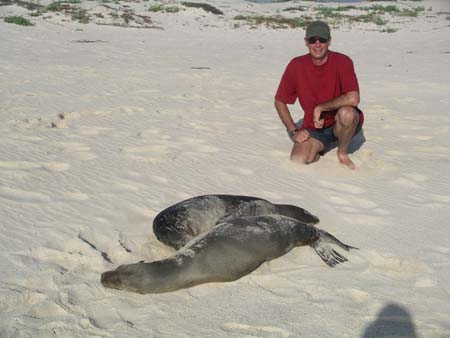 he
would disappear for a moment, and then all of a sudden we'd see him swimming
directly at us, veering out of the way only at the last instant. We drifted
in the water playing with this delightful sea lion for 20-30 minutes and got
out of the water only when the naturalists told us that we needed to return
to the ship. Even as we walked along the beach, preparing to leave on the
zodiac, he followed us closely. As we prepared to leave, he swam up to shore,
poked up his head, and looked at us as if to say, "Can't you stay and
play a bit longer!" The entire experience left us in awe, and is one
we'll certainly never forget.
he
would disappear for a moment, and then all of a sudden we'd see him swimming
directly at us, veering out of the way only at the last instant. We drifted
in the water playing with this delightful sea lion for 20-30 minutes and got
out of the water only when the naturalists told us that we needed to return
to the ship. Even as we walked along the beach, preparing to leave on the
zodiac, he followed us closely. As we prepared to leave, he swam up to shore,
poked up his head, and looked at us as if to say, "Can't you stay and
play a bit longer!" The entire experience left us in awe, and is one
we'll certainly never forget.
Tomorrow we get back to the "regular" schedule of two daily activities. In the morning, we'll hike and snorkel at Bartholomew Island which is supposed to have some amazing volcanic formations and also some fantastic marine life. In the afternoon, we'll snorkel and hike on nearby Santiago Island.
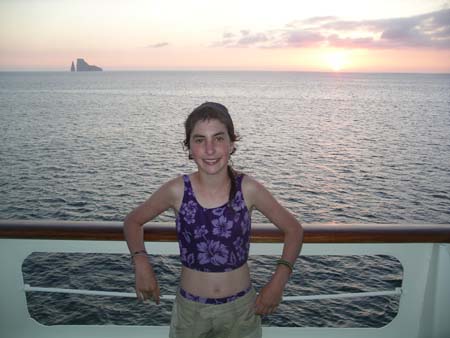
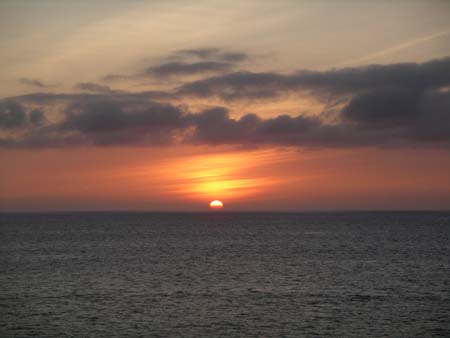
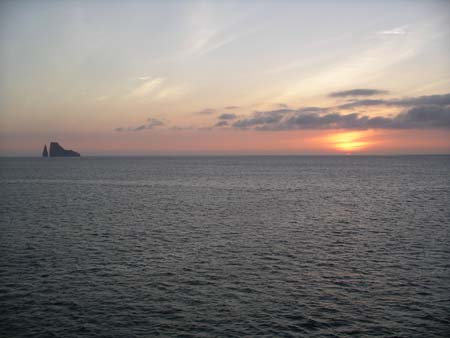
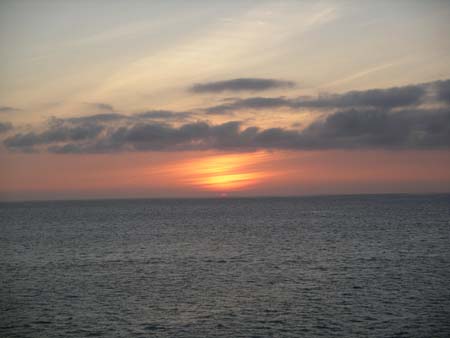
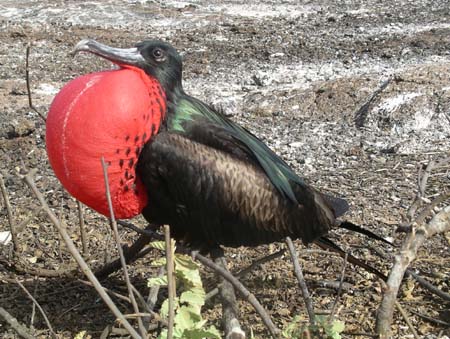
David's Daily Dump: Frigate birds. Throughout our stay here in the Galapagos, we have seen many colonies of Frigate birds in the middle of courtship season. Ever time we see them we are amazed, amused, and fascinated. It's so cool to see the males blow up their red pouches, shake their wings, and gobble like a turkey while they try to attract mates. All our guides say that we are extremely lucky to see this and that it is one of the best things to see on the archipelago.
Yesterday on Genovasa Island, we walked through a huge frigate bird colony
which was our first real encounter with these magnificent birds. There must
have been over 100 birds circling over the nesting site, and 50 others on
the ground either sleeping or calling for mates. Most of the males were on
the ground with their pouches inflated and the females were flying looking
for males that they were impressed with. I can't explain how hilarious it
was to watch a group of males suddenly start shaking uncontroll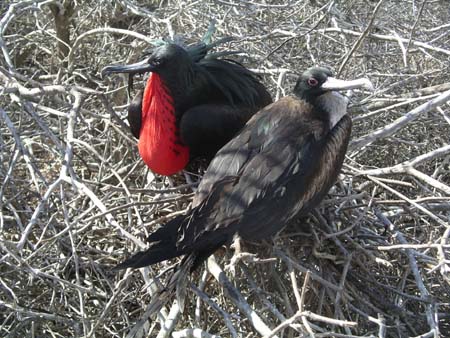 ably
as a female flew overhead. They would point their beaks up to the sky, spread
out their wings, start gobbling, and puff up their red pouches until they
were about to burst. It was like "the wave" at a baseball game.
We never saw a female come down to greet a male, and most of the time we just
thought that they were harassing them.
ably
as a female flew overhead. They would point their beaks up to the sky, spread
out their wings, start gobbling, and puff up their red pouches until they
were about to burst. It was like "the wave" at a baseball game.
We never saw a female come down to greet a male, and most of the time we just
thought that they were harassing them.
Although we didn't see any pairs being made, we did see many males with mates. The ones with mates all had a proud look on their face as if to say "I am more impressive than all of you." Some of the males even had their wings spread out over their female! It looked like the male was shading the female from the sun while she took a nap. It was really cute, and everyone always ahhhhhhhed when they saw it. I loved following the females (easily recognizable because of their white chest) through the air, and listening for the gobbling from the ground.
The Galapagos Islands are home to the Magnificent Frigate and the Great Frigate
bird (2 out of the 5 on earth). These birds are considered robbers because
of their thief-like habits. They are known to make boobies regurgitate their
catch and evacuate their nests for their own use. The frigate birds are not
solely  dependant
on other birds for food. In fact, they also fish out in the open seas in addition
to stealing from boobies. They are masters of the sky and can glide for a
long period of time without flapping their wings.
dependant
on other birds for food. In fact, they also fish out in the open seas in addition
to stealing from boobies. They are masters of the sky and can glide for a
long period of time without flapping their wings.
Seeing the remarkable birds during the mating season is truly a marvelous sight. It's unbelievable to see the males with their sacks blown up to the size of a partly-filled soccer ball, while searching the sky for females. It was an experience that I will never forget.
